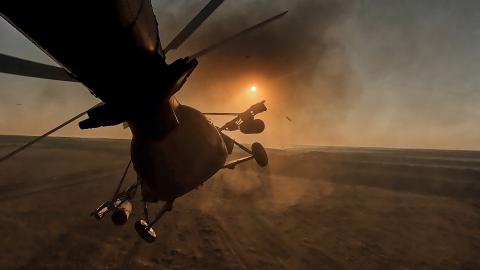This report first appeared as a part of Hudson's Re: Ukraine newsletter series. To subscribe, click here.
Below Hudson Senior Fellow Can Kasapoğlu offers a military situation report about the war in Ukraine.
Executive Summary
Ukraine destroyed an important Russian ammunition train in Tokmak, but Kyiv’s gains have largely stalled in the south as changing weather threatens to limit armored maneuver operations in the coming weeks.
Russian missile salvos continued to pound Ukrainian cities, and Kyiv expects a record hike in kamikaze drone attacks—mainly featuring Iranian Shahed drones—this coming winter.
Some evidence suggests that Ukrainian special forces units may be hunting Wagner Group personnel in Sudan.
Russia’s limited intelligence capability, along with Ukraine’s extensive rail network and excellent repair capabilities, have made it more difficult for Russia to disable Ukrainian rail infrastructure.
1. Battlefield Update
This week in Ukraine saw no important shifts in territorial control or changes in battlefield geometry. The most newsworthy development was the Ukrainian military’s successful destruction of a Russian ammunition train in the city of Tokmak. As last week’s edition of this report emphasized, Tokmak, which remains the command and control and logistics hub of the Russian occupation forces in the south, is a key target for Ukraine. This week’s attack suggested that Ukrainian forces have perhaps achieved fire-control reach over the town, probably by employing HIMARS multiple-launch rocket systems. If so, this marks a notable tactical achievement.
Nonetheless, Russian combat formations have intensified their attempts to envelop and halt Ukraine’s gradual progress in the south. These efforts have failed to alter dynamics in the Robotyne bulge and near Verbove. Yet Ukraine’s offensive combat operations along the Velyka Novosilka and Orikhiv assault axes, the primary components of its counteroffensive push, have seemingly reached their limits. Ukraine can still make progress along these axes, but it would need to augment its force generation capacity to do so.
Worryingly, Russian missile salvos and drone strikes continued to pound Ukrainian cities this week, targeting food infrastructure in the Black Sea coastal city of Odesa, as it has since the Kremlin’s withdrawal from the grain deal. Its weapons of choice in these attacks remain the Iran-manufactured Shahed-131 and Shahed-136 loitering munitions, launched in a high operational tempo. The frequency of these munitions’ use in combat suggests that the Tatarstan drone plant mentioned in last week’s edition of this report may already be in its initial stages of operation. The Ukrainian Air Force said that Kyiv is anticipating a record hike in kamikaze drone attacks this coming winter.
Weather forecasts predict rain showers over Ukraine within the week, promising to muddy the terrain in the theater of operations. This change in the battlefield would limit armored maneuver operations, but would not drastically alter small infantry unit tactics, artillery exchanges, or counter-battery fire.
2. Is Ukrainian Defense Intelligence Preying on Wagner in Sudan?
A recently released video upload depicting a Ukrainian Defense Intelligence (GUR) sniper positioned in rocky terrain with a suppressed rifle has fueled speculation that Ukrainian GUR detachments might be pursuing Wagner personnel in Sudan.
The upload offers no verifiable geolocation inputs. The scene, however, resembles the stony, red-sand desert terrain of Sudan. More important, September 2023 attacks on Sudan’s anti-government Rapid Support Forces involved first-person view (FPV) drones of the sort typically used by the Ukrainian military.
Wagner is collaborating with the Rapid Support Forces in Sudan in the latter’s fight against the Sudanese military. The Russian private military company also runs lucrative mining businesses in the African country that could justify its military presence there.
The GUR has also established a foothold in Sudan in the past. When hostilities broke out there in April 2023, it evacuated 138 Ukrainian citizens and posted the operation on its official Facebook page, so it has experience dispatching liaison and special forces teams to Sudan. Moreover, General Kyrylo Budanov, the chief of Ukrainian Defense Intelligence, has previously advocated a policy of hunting down Russian war criminals wherever they may be.
While more evidence is required to conclude that Ukrainian personnel are pursuing Wagner in Sudan, the possibility raises intriguing new questions for the conflict.
3. Russia Continues Attacks on Ukrainian Railways
As winter descends over Ukraine, both parties to the conflict are focusing on disrupting the other side’s railway logistics. As the Ukrainian military has struck Tokmak, so have Russian forces been targeting Ukrainian trains.
Russian air superiority prevents Ukraine from using its airspace as it would like. This limitation makes Kyiv more dependent on trains, which form the nation’s main means of transport for troops, goods, and military equipment. Ukrzaliznytsia, Ukraine’s state-owned railway transport and infrastructure giant responsible for much of its 15,000 miles of track, remains essential to Kyiv’s war effort. As a result, Russia has targeted Ukraine’s train stations and critical railway hubs since the outset of the war. One week ago, in Zaporizhzhia, Russian missile forces used an Iskander ballistic missile to hit a Ukrainian logistics train carrying equipment.
Two factors make it difficult for Russia to attack Ukraine’s railways. First, it lacks the ability to harvest and analyze high-end satellite intelligence. Field reports from Ukraine suggest that the Ukrainian Armed Forces recently managed to transport multiple large-size combat formations along railways without being interrupted by Russia’s long-range strike deterrent. Second, Kyiv’s extensive rail network, as well as its excellent repair capabilities, make targeting difficult. Still, given the centrality of rail to Kyiv’s war planning, Russia is likely to ramp up its attacks on Ukraine’s logistical network.














